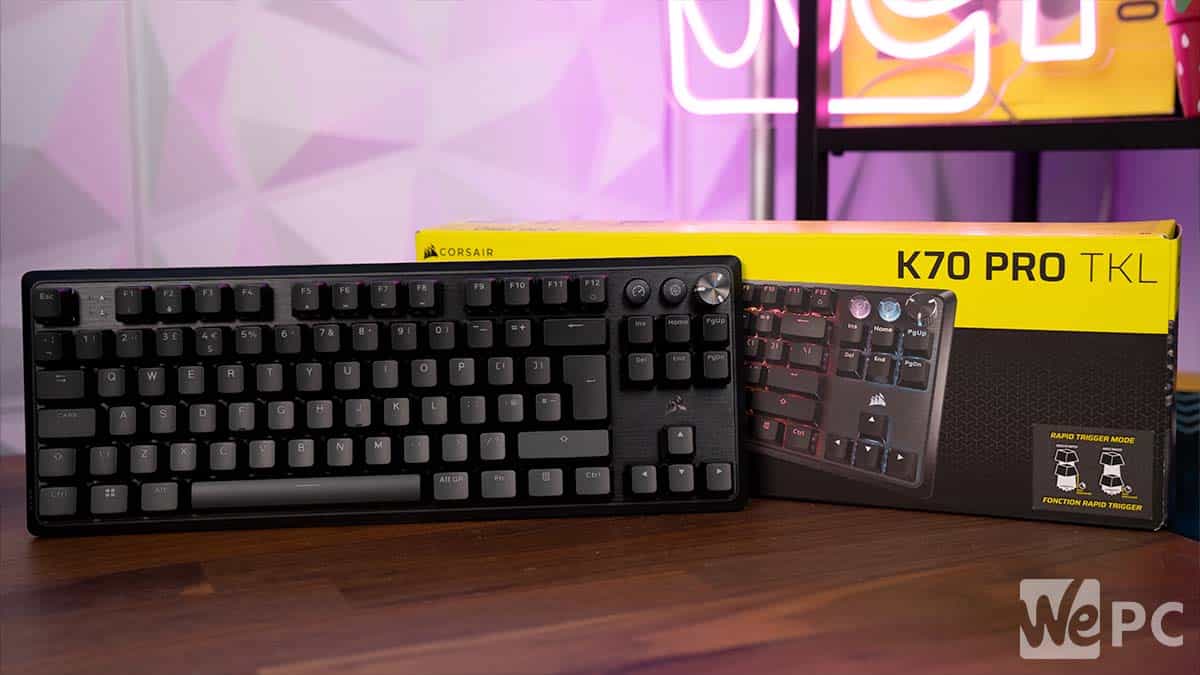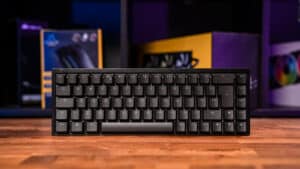Corsair K70 PRO TKL review: designed to prioritize every millisecond
Takes gameplay to the next level with top-tier response

WePC is reader-supported. When you buy through links on our site, we may earn an affiliate commission. Prices subject to change. Learn more
Corsair has just launched the new K70 PRO TKL gaming keyboard and we’re putting it through its paces to see how it stacks up against the market’s leading rivals.
Corsair’s latest gaming keyboard delivers cutting-edge features that are designed for gamers who prioritize performance, right down to the last millisecond. The new K70 PRO TKL keyboard features all the bells and whistles you could want for an esports-grade gaming experience, including; SOCD technology, MGX Hyperdrive switches, and an 8,000 Hz polling rate. On paper, this keyboard is right up their with the best TKL keyboard on offer right now – delivering industry leading speeds and customization. But how will it stack up against leading alternatives in the sub $200 price point?
In our review, we’ll be taking a closer look at Corsair’s latest esports-ready board to see whether it has what it takes to punch through an increasingly popular price band. Is the K70 PRO TKL worth the high price tag? Let’s dive in and find out.

- Form Factor: TKL
- Key switches: MGX Hyperdrive Magnetic switches, MLX Plasma, MLX Red V2
- Actuation: 0.1mm – 4.0mm
- Dimensions: 366mm x 135mm x 39.8mm
- Connections: USB Type-C
The Corsair K70 PRO TKL is a decent keyboard that offers up all the features you could want for a great gaming experience. Equipped with the latest features, the K70 PRO TKL is a fine choice for competitive gaming, offering up industry leading speeds and technologies. Despite the feel and build quality of the keyboard not quite up to the standards I’d expect, Corsair has still managed to produce a keyboard that shines in a price point that is increasingly competitive.
- Fast response
- 8,000 Hz polling rate
- Adjustable actuation point
- Stylish aesthetic
- Feature-rich design
- Lacks premium feel
- Low 30g actuation force can be problematic when typing
K70 PRO TKL review: at a glance
Overall, the K70 Pro TKL was a decent board to use, offering up an excellent array of features geared up for giving you the edge over the competition. Below, we’ll list the main things you need to know about this board:
- Launching for $189.99 (Non-PBT version will cost $179.99)
- Available in all white or all black variants
- Features 8,000 Hz polling rate
- Equipped with SOCD technology
- Utilizes MGX Hyperdrive magnetic switches
- Game mode quick switch for toggling presets
- Excellent customization within iCUE software
- Build quality is slightly underwelming
- Linear switches are not for everyone
Specifications and price
The K70 Pro TKL will become the lineup’s second most expensive keyboard upon launch, retailing for $189.99 (if you opt for the PBT version). That said, there will be a non-PBT model available that will set you back $179.99. At that price, the new esports-ready gaming keyboard hits a very competitive price point that is already populated by top models from leading rivals. It’ll be interesting to see how the keyboard is received – especially with so many sub $200 keyboard on offer right now.
Design & Gallery
Corsair have delivered a sleek and stylish looking board with the K70 Pro TKL, offering up a premium look and feel that should suit almost any gaming setup. The brushed aluminum top cover is a nice touch from Corsair that helps bring home that top-end feel. The keycaps feature a smooth, almost glossy finish that contrast nicely with the brush aluminum plate, providing users with a silky typing feel during gaming or work.
In the top right, we find the board’s game mode switches and audio controls. The audio dial offers a distinctive ‘click’ when muting the audio, alongside definable steps for volume changes. Both game mode + iCUE buttons feature plastic covers that allow RGB to shine through clearly. When enabling your game mode settings, the board rolls over a red RGB preset to let you know it’s enabled; a nice touch, but one that can be altered in the software suite if it isn’t to your liking.

Corsair’s branding can be found above the arrow keys (a simple logo) and on the detachable wrist rest (horizontally in the middle). Speaking of wrist rests, Corsair have included an attachable rest with the K70 Core TKL that easily snaps into place via the magnetic strip at the top. The rest features a slightly textured feel that helps with grip during gaming sessions, alongside a simple design that doesn’t take anything away from the board’s core aesthetic.

Like many of the other models within the K70 lineup, the PRO TKL’s USB Type-C input is found on the top-left edge; allowing users to more effectively cable manage their desktop real-estate.
The rear of the board doesn’t have a great deal to offer, besides one-stage feet that help elevate the board for a more comfortable typing feel. Corsair branding can also be found on the rear, alongside some etchings that, well, don’t really do anything. Overall, you’d have to say that the K70 PRO TKL is a solid looking board – especially through gamer’s eyes. For me, I’m not a huge fan of the “open” board style – where users can see the switches under the keycaps. But on this board, it works nicely.

Features that prioritize response
With a fairly substantial retail price, you’d expect the K70 PRO TKL to come with an extensive list of features; fortunately, Corsair delivers on this front.
As previously mentioned, Corsair equips the esports-ready gaming keyboard with MGX Hyperdrive magnetic switches, first seen on the brand’s MAX model. The pre-lubed switches not only offer a silky smooth typing feel, but also deliver incredibly fast responsiveness that claims to give you the edge over the competition – or “react faster and overtake all opponents”, as they put it.
Taking a closer look at the switches, Corsair’s marketing materials state that the Hyperdrive switches offer a rather delicate 30-55g actuation force. While this is great for gaming – delivering super-quick response – I did find the sensitive actuation force rather problematic when typing long articles or reviews. It just seemed like typos would crop up more frequently when compared to other boards I’ve tested.
Typing feel is subjective
Worth noting, this is a subjective factor, so I’d advise testing this thing for yourself before making any firm judgements on the typing feel.
The MGX Hyperdrive switches this board comes with feature a double-rail design structure that provides a tighter, more robust feel with less wobble. Better yet, gamers will be able to customize the actuation distance of the switches between 0.1mm-4.0mm – essentially allowing you to set keypress actuation to almost instantaneous.
Alongside this, Corsair brings FlashTap SOCD technology to the table with this board, allowing users to optimize keypresses across every game and genre. Essentially, the technology allows numerous keys to be pressed at the same time, allowing players to more precisely hit movements or commands that may not have been possible otherwise. This is a great resource to have when playing competitive games like CS2 and COD, as twitch-peaking and strafing are widely used in competitive play.
Keeping with the “need for speed” agenda, Corsair has added 8,000 Hz polling rate to the PRO TKL via AXON Hyper-processing technology. Again, this is another feature tailored purely towards competitive players who want to gain every possible advantage over their competition. Most modern gaming keyboards feature polling rates of up to 1,000 Hz, effectively making the K70 PRO TKL 8 times faster than lesser-specced alternatives. While that sounds great, we’d always take these sorts of features with a pinch of salt. Nice to have, but real-world differences are quite small.
As touched upon earlier, the K70 PRO TKL features game mode buttons at the top right hand corner of the board – allowing users to quickly switch to a predefined game mode preset. Simply click the button and the keyboard will instantly load up your desired game settings. The out-the-box preset offers changes such as; disabling the Windows key, tightening up latency and actuation points, adjusting specific key bindings, and locking the RGB to red to display the new profile. Of course, you can tweak this inside the Corsair iCUE software package, with 5 unique profiles available onboard.
Overall, the K70 PRO TKL has a tonne of features that allow players to fine-tune the gaming experience to their exact needs. But, how do all those features stack up in real-world gaming situations? Let’s find out
Game changing performance
Before discussing my thoughts and feelings towards this board in gaming scenarios, it’s worth mentioning that I use the Ducky X Varmilo Miya Pro Sakura as my everyday board – so I’ll be using that as reference during the performance section.
I begin by firing up my favorite first-person shooter, CS2. I launched deathmatch up and started putting the board to the test – instantly enjoying the feel of the board. Granted, it took me a little while to get the feel of the board down (I’ve been using the Ducky for nearly 5 years) but once I did, it was an incredibly enjoyable feel. Each keypress felt well-defined and reactive – and that was without setting a game mode. I quickly enabled the out-the-box preset and, while some aspects of the board did feel slightly refined, there wasn’t a massive noticeable difference between the two. While that sounds like a negative, it’s not really – I’m just trying to highlight the quality of the board right out of the box.
Personally, the most appealing feature of the K70 PRO TKL was the SOCD technology. If you’re a competitive CS player, you’ll understand the importance of accurate twitch-peaking. If you haven’t got that down, you’ll soon fall victim to a quality AWP player or on-point rifler. That said, the keyboard’s SOCD tech made sure I was never stuck out in the open when counter strafing. an excellent feature to have when playing CS.
The super-quick responsiveness of the PRO TKL was definitely noticeable when comparing it the MIYA Sakura; a board that only features a 1,000 Hz polling rate. That being said, there are a few areas that I didn’t like that much. Firstly, the linear feel to the MLX Plasma and Hyperdrive switches was not for me. I’m a tactile kind of player – I want that feedback from the keys when they’re being pressed.
Final word

Corsair K70 PRO TKL


























